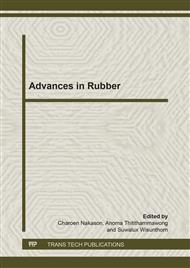p.338
p.345
p.349
p.353
p.357
p.361
p.365
p.369
p.373
Gel Polymer Electrolyte from Ozonolysis of Poly(3-(trimethoxysilyl)Propyl Methacrylate) Graft on Natural Rubber Latex for Natural Dye Sensitized Solar Cell Application
Abstract:
The dye sensitized solar cell (DSSC) is devices for converting solar energy to electricity. The gel polymer electrolyte is the main component in the cell. It is used for complexation with liquid electrolyte to generate iodide ions and support the ion transportation. The gel polymer electrolyte of poly(3-(trimethoxysilyl) propyl methacrylate) (PMPS) coat on the surfaces of natural rubber (NR) particles (PMPS-g-NR) was prepared by surface grafting emulsion polymerization method using the redox couple initiator, tetraethylenepentamine (TEPA) and cumenehydroperoxide (CHP). Then, this gel was treated by ozone at different treatment time (5 min, 10 min, 20 min, 25 min, and 30 min) and voltage of ozonolysis (0.7 kV, 1.5 kV, 2.4 kV, and 3.2 kV) on PMPS-g-NR (ozonolysed PMPS-g-NR) to obtain the optimum condition for generating the active species e.g. carbonyl or aldehyde structures. The synthesized materials were characterized by the degree of swelling (%DS), ionic conductivity, and solar cell efficiency, having red cabbage as dye sensitizer. By ozonolysis on PMPS-g-NR, the treatment condition of voltage at 3.2 kV and treatment time at 30 min showed the maximum %DS of 74.2, which is higher than that of PMPS-g-NR without ozonolysis of 65.5. The maximum ion conductivity of PMPS-g-NR and ozonolysed PMPS-g-NR at 2.4 kV and 20 min were 0.240 mS/cm and 0.775 mS/cm, respectively while their maximum solar cell efficiency was 6.738 m% and 10.340 m%, respectively.
Info:
Periodical:
Pages:
357-360
Citation:
Online since:
November 2013
Authors:
Price:
Сopyright:
© 2014 Trans Tech Publications Ltd. All Rights Reserved
Share:
Citation:



